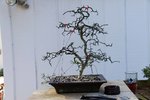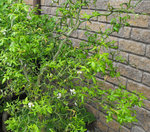You are using an out of date browser. It may not display this or other websites correctly.
You should upgrade or use an alternative browser.
You should upgrade or use an alternative browser.
The Flying Dragon
- Thread starter Mellow Mullet
- Start date
Forsoothe!
Imperial Masterpiece
Vance Wood
Lord Mugo
It is possible to remove the thorns.
Forsoothe!
Imperial Masterpiece
Isn't that a lot like growing a flowering tree that you always remove flower buds from? Not less than 50% of the attraction of this species is the branch form and the thorns are just a modified branch.It is possible to remove the thorns.
Mellow Mullet
Masterpiece
It is possible to remove the thorns.
You can, but the white underneath is unattractive and since the branch is green it is difficult to find a cut paste to match. You would need to be careful when cutting them off as the new leaves emerge from the branch right at the base of the thorn. Part of the beauty of the plant is the thorns, they are contorted too.
penumbra
Imperial Masterpiece
Removing the thorns on this plant would remove most of its charm.
Tieball
Masterpiece
I think they naturally grow in that contorted look. I think the plant grows contorted to challenge anyone who is even thinking of pruning it. When you cut back you get even more contortion.This is such a cool species, I had to order a couple seedlings. They aren't contorted and I'm not sure if I'll try bonsai or just container grown. Either way, thanks for sharing.
penumbra
Imperial Masterpiece
Yes, and "Flying Dragon" is a cultivar that is more contorted than the species. Unfortunately a lot of people are selling seedlings as Flying Dragon, and they are not. It has to be a cutting or a graft.I think they naturally grow in that contorted look. I think the plant grows contorted to challenge anyone who is even thinking of pruning it. When you cut back you get even more contortion.
Forsoothe!
Imperial Masterpiece
No, you won't like the uncontorted form. They have long internodes and very long thorns.
Tieball
Masterpiece
Good idea.....have fun with all the contorted views. It can be a different view every week or so. Interesting engagement.Hmm, maybe I'll just grow these in a container as a large house plant then.
If anyone had a lead on cuttings of true flying dragon, let me know please.
i don’t know if they grow indoors....my inclination is strictly outdoors.
Mellow Mullet
Masterpiece
I think they naturally grow in that contorted look. I think the plant grows contorted to challenge anyone who is even thinking of pruning it. When you cut back you get even more contortion.
There are two types of poncirus trifoliata, one is contorted and called the "flying dragon", the other is really straight, the thorns are straight too, I have one, I will take a picture when i am off again.
Mellow Mullet
Masterpiece
Yes, and "Flying Dragon" is a cultivar that is more contorted than the species. Unfortunately a lot of people are selling seedlings as Flying Dragon, and they are not. It has to be a cutting or a graft.
Not necessarily true, my dad has a flying dragon that fruits. He plants the seeds and the seedlings are about 60% regular and 40% contorted, so you can get one as a seedling. Both of mine are seedlings from his tree.
Mellow Mullet
Masterpiece
Hmm, maybe I'll just grow these in a container as a large house plant then.
If anyone had a lead on cuttings of true flying dragon, let me know please.
My dad may have some seedlings, I'll ask for you.
My dad may have some seedlings, I'll ask for you.
That would he awesome, thanks.
penumbra
Imperial Masterpiece
The botanical name is Poncirus trifoliata and "Flying Dragon" is a dwarf form with highly contorted growth. It is closely related to citrus but is actually in a genus of its own. It can however be used as a rootstock to add extra hardiness to orange trees. It is hardy zone 6 to 9, so it might be possible to grow it inside but it would not be easy without a greenhouse. If I recall correctly, it is from China. In colonial times it was pruned into an impenetrable hedge. I remember about 20 years ago I did a lot of landscape installations for a client who had a large one that had been planted sometime in the 1940s. It was about 8 to 10 feet tall and the customer really hated it. I talked her into keeping it because it was quite a beautiful plant with bright evergreen stems. Her plant was pretty contorted but it was nothing like the Flying Dragon.
I found two grafted plants on eBay last year and they are now in a covered hoop house for winter. I think I paid $18 each for them. They are available but be wary of anyone selling seeds. I have seen seeds on eBay, Etsy and Amazon. Buy a plant and if possible buy a plant you have seen in life or pictures.
Beware of seedlings. They are not the real thing.
I found two grafted plants on eBay last year and they are now in a covered hoop house for winter. I think I paid $18 each for them. They are available but be wary of anyone selling seeds. I have seen seeds on eBay, Etsy and Amazon. Buy a plant and if possible buy a plant you have seen in life or pictures.
Beware of seedlings. They are not the real thing.
Mellow Mullet
Masterpiece
The botanical name is Poncirus trifoliata and "Flying Dragon" is a dwarf form with highly contorted growth. It is closely related to citrus but is actually in a genus of its own. It can however be used as a rootstock to add extra hardiness to orange trees. It is hardy zone 6 to 9, so it might be possible to grow it inside but it would not be easy without a greenhouse. If I recall correctly, it is from China. In colonial times it was pruned into an impenetrable hedge. I remember about 20 years ago I did a lot of landscape installations for a client who had a large one that had been planted sometime in the 1940s. It was about 8 to 10 feet tall and the customer really hated it. I talked her into keeping it because it was quite a beautiful plant with bright evergreen stems. Her plant was pretty contorted but it was nothing like the Flying Dragon.
I found two grafted plants on eBay last year and they are now in a covered hoop house for winter. I think I paid $18 each for them. They are available but be wary of anyone selling seeds. I have seen seeds on eBay, Etsy and Amazon. Buy a plant and if possible buy a plant you have seen in life or pictures.
Beware of seedlings. They are not the real thing.
Well, yes they are, like I mentioned above, both of mine are seedlings. The fruit is almost all seed, and when you sow them, only about 40% are contorted. So yes, a seedling is the REAL THING. Just make sure that it is exhibiting contortion, they start contorting pretty early.
Similar threads
- Replies
- 2
- Views
- 777







